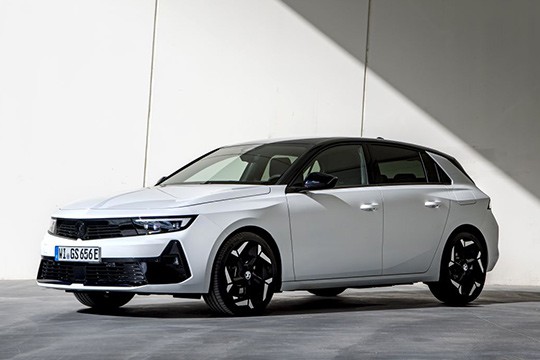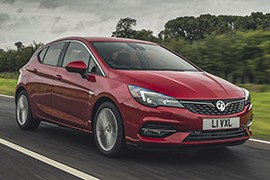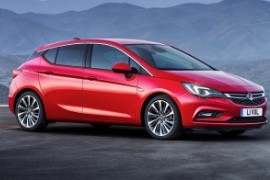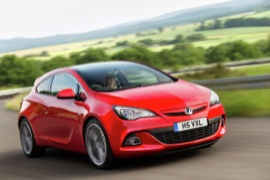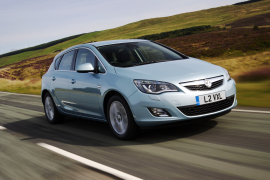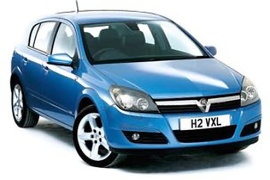VAUXHALL Astra Hatchback Models/Series Timeline, Specifications & Photos
First production year: 2004
Engines: Plug-in hybrid, Gasoline, Diesel
Body style: Hatchback
Vauxhall introduced the GSe version of the Astra L in late 2022, offering customers a potent plug-in hybrid that could travel up to 40 miles (64 km) on batteries only.
The British brand was already part of the Stellantis automotive giant in September 2022 when it introduced the Astra Hatchback GSe, the Astra Sports Tourer GSe, and the Grandland GSe. The new version was the answer to those who asked for a more potent version of the popular compact hatchback. But the wait was worth it since the car delivered exhilarating accelerations and a generous all-electric range that could help people drive the vehicle mostly on electrons alone.
The Astra L generation sported a new design element at the front, known as the Vauxhall Vizor. It featured a broad grille fitted with horizontal slats and flanked by angular-shaped headlights. They featured the already specific L-shaped daytime running lights mounted on their upper outer corners. Lower, on the apron, a second broad air intake was flanked by a pair of side scoops that housed the fog lamps. In addition, a longitudinal crease on the hood emphasized the car’s angular shape and sporty character.
From its profile, the Astra L kept the sculptured lower line that crossed the door panels like on the previous two generations of the car, but with an angular shape instead of the organic, curved one of the Astra J and K, respectively. To emphasize the sporty character of the GSe version, the automaker installed a specific suspension for it that lowered the ground clearance by 10 mm (0.4 inch). In addition, the wide 18” light alloy wheels completed the image. Finally, at the back, the raked-forward tailgate sported the taillights that were extended on it from the rear quarter panels while a roof spoiler adorned it.
Inside, Vauxhall has carried over some of the technological features developed by Peugeot, its owner, since 2017. On the dashboard, the automaker installed a pair of two 10-inch displays. The one fronting the driver was for the instrument panel, while the touchscreen above the center stack was for the infotainment system. Customers could find Alcantara-wrapped high-bolstered seats at the front. These were separated by a wide center console that housed the transmission controller, a couple of cup holders, and a storage compartment. In the rear, the split-folding bench seat could accommodate three passengers for short jaunts or two for longer trips.
Under the hood, Vauxhall installed a 180 PS (177 hp) turbocharged gasoline engine from Peugeot. This was helped by a 110 PS (108 hp) electric motor fed by a 12.4 kWh battery. As a result, the combined total power output of the vehicle was a respectable 225 PS (222 hp) sent to the front wheels via an eight-speed automatic transmission.
Four years after the car's launch and two after the company's takeover by the French group PSA, Vauxhall refreshed the Astra K lineup, adding more technology to a car that was already famous.
The Astra nameplate was well-known in UK. According to Vauxhall's studies, a quarter of the British drivers either had one or drove one in their life. It was one of the most popular cars in the country, and the automaker tried to convince customers that despite losing its link with General Motors, it was still worth it. Besides, the car's design was praised, and the 0.26 drag coefficient was one of the best on the market. Along with the refreshed version, the automaker improved the car's engines and onboard technology.
At the front, the car could be equipped with new IntelliLux headlights that could alter the number of LEDs lit to avoid blinding drivers from the oncoming traffic. In addition, the forward-mounted cameras could read traffic signs and road lines. It could also detect obstacles and warn drivers. The sharp-looking front fascia featured a new grille adorned by a 3D mesh design. On the lower bumper, the available LED fog lamps were housed by the side scoops that flanked the air center air intake.
With a sporty-looking profile, the Astra K, as enthusiasts knew this car, sported an ascending beltline and a floating roof design emphasized by a black decoration on the C-post. A chromed trim adorned the upper side of the window line, while the lower one was black. Also, the B-post was black to create a coupe-like shape for the car. The company's new owner kept the same sculptured door panels even if these were more expensive to produce than the flat ones. Finally, at the back, the raked-forward tailgate featured a roof spoiler mounted on the upper side of the rear window. The stretched taillights extended from the quarter panel onto the metallic part of the tailgate looked sharp and echoed the headlights' design. Lower, on the bumper, the automaker completely concealed the tailpipes.
Inside, customers could find the same comfortable front seats developed with the German Institute for Back's Health. Between them, the automaker installed a wider center console that housed the gear stick, a storage tray, and the armrest. Vauxhall installed an open storage compartment on the center stack underneath the stereo. Fortunately, the Astra didn't have as many buttons as its predecessor, the Astra J. Instead, it had a new infotainment unit mounted atop the center stack, which included navigation and integration for Apple CarPlay and Android Auto. It also benefited from the OnStar communication system that provided assistance to drivers. In the back, the bench seat could host three passengers on short trips.
Under the hood, Vauxhall installed punchier engines, some of them being carried over from Peugeot-Citroen. The 1.0-liter turbocharged powerplant was history and replaced by a 1.2-liter unit. In addition, a 1.5-liter inline-four turbo diesel promised customers an excellent fuel efficiency.
The seventh generation of the Vauxhall Astra was introduced in 2015, and it was the swan song for the GM-owned brand since two years later, the British automaker was sold to the French group PSA.
After the world financial crisis, Opel/Vauxhall was still in deep financial trouble. They tried everything to get out of the debt and survive in the grueling market after 2010. While other brands thrived and launched better and better products, these GM-owned European automakers couldn’t keep up with the changes. Their vehicles were better than before, but their competitors were even better than them. Still, the Astra K, as it was known this generation, was improved in every aspect and even overtook some of its competitors in some aspects. But it was not enough to save the European arm of GM.
GM’s styling team created an organic language for the 2015 Astra hatchback, like on the previous generation of the car, but with sharper lines. The car’s headlights incorporated the LED daytime running lights that underlined the headlamps. On the upper grille, the automaker installed the wing-like double-slat that supported the Vauxhall badge and completed the design with a 3D mesh underneath it. On the lower bumper, the Astra K featured a slim, trapezoidal-shaped lower grille flanked by a set of side scoops where the optional foglamps could be housed.
The car’s profile revealed a crease that crossed the car, starting from the front fenders’ turn signals to the rear taillights, across the vehicle at the door handles’ level. This generation of the Astra also sported the floating-roof styling, where the C-pillars featured a black area that made the roof look like it was separated from the rest of the vehicle. To further emphasize this illusion, the automaker installed black B-posts. Finally, at the back, the wide taillights echoed the shape of the headlights, being stretched from the quarter panels to the metallic area of the tailgate. But Vauxhall wanted this car to look sporty, so it made a raked-forward rear window adorned with an upper roof spoiler that included the third brake light.
Inside, the car abounded on high-quality materials that adorned the dash panel, the door cards, and most of the contact areas. Vauxhall installed a seven or eight-inch touchscreen for the infotainment system, depending on the trim level and options. It also provided Apple CarPlay and Android Auto for selected versions. Another big improvement over the previous generation was the introduction of the OnStar assistance system that could help customers locate their cars, lock or unlock them via a phone app, and automatically call emergency services in the event of a crash. The nice-looking piano-black trims on the dashboard and center console created an upscale image for the compact hatchback. In the back, the Astra K offered plenty of room for adult-sized passengers thanks to its long wheelbase of 2.66 meters (104.8 inches).
Under the hood, Vauxhall installed a range of new engines ranging between 105 PS (103 hp) and 150 PS (148 hp) paired with a six-speed manual or a six-speed automatic. Besides the gasoline powerplants, the automaker also installed a range of diesel powerplants known for their fuel efficiency.
The sixth generation of the Astra broke cover in 2009 at the Frankfurt Motor Show, and GM sold the car under the Vauxhall brand in UK, continuing a long line of successful stories for this compact vehicle.
In 2009, Opel/Vauxhall unveiled the Astra as a hatchback, and in the following year, it was unveiled as a station wagon, also named Sports Tourer, at the Paris Motor Show. But customers also expected other shapes, including the three-door version known as the GTC (Grand Tourer Compact). Unlike its brothers, this version was aimed at the younger generation due to its sporty shape and punchy engines. Unfortunately, the timing was not the best possible since the world financial crisis that affected all automakers bit hard from GM’s European arm. Still, the GTC was appreciated, and Vauxhall’s fans waited for it.
With a new front fascia that resembled the Vauxhall Insignia, the GTC featured L-shaped daytime running lights integrated into the headlights. Between them, the automaker placed a narrow grille adorned by a chromed slat that supported the automaker’s badge. The 2011 GTC featured a more aggressive lower bumper design than the rest of the Astra range. It had a broad lower grille flanked by a pair of side scoops that housed the fog lamps.
While it wasn’t the first GTC in the Astra’s history, the 2011 model year came with a few enhancements that made it special. Like its predecessors, it was not a three-door version of the five-door hatchback. Its raked windshield, followed by a curved roof, made it special. From its profile, the sculptured lines that adorned the doors and the rear quarter panels created a dynamic image for the car. Finally, at the back, the raked-forward tailgate was adorned by the taillights. These, in turn, were extended from the rear quarter panels onto the tailgate’s panel.
Inside, the automaker offered a set of bucket seats. Between them, the automaker placed a center console that housed the infotainment’s system rotary button, the gear stick, and the handbrake. At the front, the bucket seats provided little side bolstering, but Vauxhall offered an option for sports seats with high bolstered areas. The large dials of the speedometer and tachometer filled the instrument cluster that fronted the driver. Above them, in the middle, the automaker added the fuel level and coolant temperature gauges. Thanks to the stylish dashboard with a sloped-down center stack filled with buttons, the Astra GTC looked modern. In the back, thanks to the longer wheelbase than the regular five-door hatchback, there was enough legroom for the rear passengers, although the sloped-down roof line could create some headroom issues for taller people.
Under the hood, the automaker installed a wide range of diesel and gasoline paired with either a five-speed manual or a six-speed automatic. Power went to the front axle only.
Opel introduced the fourth generation of the compact segment vehicle Astra at the 2009 Frankfurt Motor Show and offered it in a few body shapes, including the hatchback, which was one of the most awaited versions of the car.
In England, GM sold the same vehicle but in a right-hand drive configuration as the Vauxhall Astra, and it was one of the most popular cars on the road in UK. The five-door version was a very appreciated vehicle thanks to its low acquisition price, low running cost, and decent reliability. Customers didn’t seem bothered too much that some materials inside the car were not at the highest standards as long as the vehicle worked and took them from A to B.
The car’s front fascia revealed an organic design with curved lines. Its headlights featured the L-shaped daytime running lights introduced by the mid-size sedan Vauxhall Insignia in 2008. They flanked a narrow grille that was adorned by a chromed trim on its upper side, which also included the carmaker’s badge. On the lower part of the bumper, the Astra featured a wide, smile-like lower grille flanked by two scoops with a leaf-like shape that could house the fog lamps when optioned.
From its profile, the sculptured lines of the door panels and the ascending waistline of the windows line created a fresh and youthful image for the five-door compact hatchback. Unlike other automakers from the segment, Vauxhall installed a third set of windows behind the rear doors. These were not significant in size but essential in terms of design and practicality since they reduced the driver’s blind spots. At the back, the Astra featured a set of taillights that echoed the headlights’ shape. They were extended from the quarter panels to the tailgate.
Inside, the perceived quality was a big step forward compared to its predecessor. GM’s designers made a center console that looked more upscale thanks to its chromed trims and position. Furthermore, a round turning knob placed on the center console between the front occupants controlled the infotainment system that sat atop the center stack. Fronting the driver was a three-spoke steering wheel and, behind it, an instrument cluster that featured large dials for the tachometer and speedometer and the gauges for the fuel level and coolant temperature. The previous generation lacked the latter indicator. In the back, thanks to the extended wheelbase over the Astra H (its predecessor), the J variant offered better legroom. As a result, the split-folding (60/40) bench seat was suitable for two adults on long journeys.
Under the hood, GM installed a wide choice of engines ranging between 87 PS (86 hp) and 180 PS (178 hp), either gasoline or turbo diesel. A few newly-developed six-speed automatic transmissions were also available for specific engine versions.
After Opel introduced the third generation of the Astra on the European market, Vauxhall launched the British version and sold it in a few body shapes, including a five-door hatchback.
The compact hatchback was received with great enthusiasm by the brand’s fans since it was a big step up in terms of design language and improvement for the quality of the materials used inside the cabin. Furthermore, the automaker had invested a lot in developing a new range of engines that were already Euro 4 emission standard compatible, which was due to become mandatory starting in January 2006. In addition, since it had a longer wheelbase and bodywork, the 2004 Astra offered a more spacious cabin than its predecessor.
From the outside, the new design language of the car was dominated by a mix of curved lines and sharp angles. The front fascia featured rhomboidal headlights swept back towards the front fenders and integrated three headlamps under the same lens for the turn signals, parking lights, and low and high beams. Between them, the automaker installed the grille that sported a thick chromed slat with a V-shaped centerpiece that supported the carmaker’s badge. The lower side of the apron was divided into three sections that added cooling areas for the engine and also housed the fog lamps when fitted.
The Astra’s profile revealed a fresh design with a raked windshield and an ascending waistline adorned by black or chromed trims, depending on the grade. Vauxhall placed trims around the wheel arches to further emphasize the youth-oriented vehicle, making them look like they were flared. Unlike its predecessor, which had a two-step shaped tailgate, the Astra H featured a curved line for it. On the rear fascia, Vauxhall installed corner-mounted taillights with smoked lenses.
Inside, GM improved the quality of the material for the Astra H and added more options to the list, including a navigation system. Even the base models featured a sound system. Depending on the engine version, the five-door hatchback featured bucket seats or high-bolstered ones at the front, especially for vehicles fitted with punchier engines. The center stack was decorated with a silver trim and black buttons, which made it look more upscale. At the same time, the narrow center console housed the gear stick and a small storage area. In the back, the automaker fitted the car with a split-folding bench seat that could expand the trunk space from a mere 312 liters (11 cu-ft) to 1,265 liters (44.6 cu-ft), which was not exactly on top of its segment.
Under the hood, Vauxhall carried over the engines from GM’s parts bin, ranging between 90 PS (89 hp) and 200 PS (197 hp), either gasoline or diesel. All engine versions were available in a three-pedal setup, while specific engine variations were offered with either a four or a six-speed automatic gearbox.
VAUXHALL Astra Hatchback 1.3L CDTi 6AT FWD (90 HP)
VAUXHALL Astra Hatchback 1.3L CDTi 6MT FWD (90 HP)
VAUXHALL Astra Hatchback 1.7L CDTi 5MT FWD (100 HP)
VAUXHALL Astra Hatchback 1.7L CDTi 5MT FWD (80 HP)
VAUXHALL Astra Hatchback 1.9L CDTi 6AT FWD (120 HP)
VAUXHALL Astra Hatchback 1.4L 5AT FWD (90 HP)
VAUXHALL Astra Hatchback 1.4L 5MT FWD (90 HP)
VAUXHALL Astra Hatchback 1.6L 5AT FWD (105 HP)
VAUXHALL Astra Hatchback 1.6L 5MT FWD (105 HP)
VAUXHALL Astra Hatchback 1.6L Turbo 6MT FWD (180 HP)
VAUXHALL Astra Hatchback 1.8L 16V VVT 4AT FWD (140 HP)
VAUXHALL Astra Hatchback 1.8L 16V VVT 5MT FWD (140 HP)
VAUXHALL Astra Hatchback 1.8L 4AT FWD (125 HP)
VAUXHALL Astra Hatchback 1.8L 5MT FWD (125 HP)
